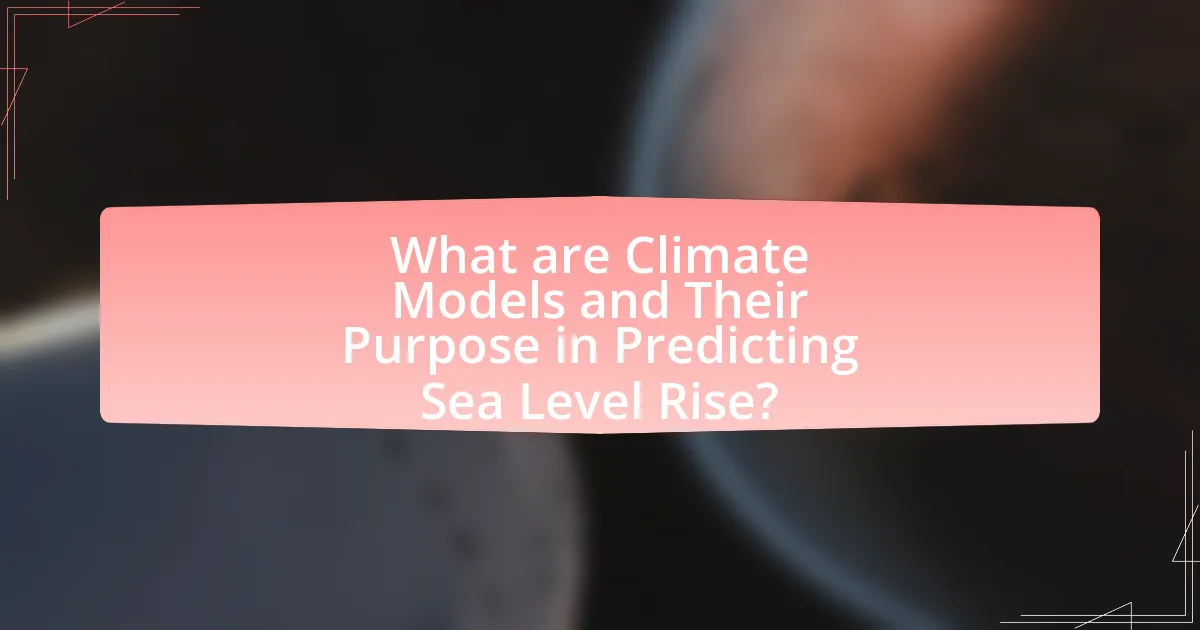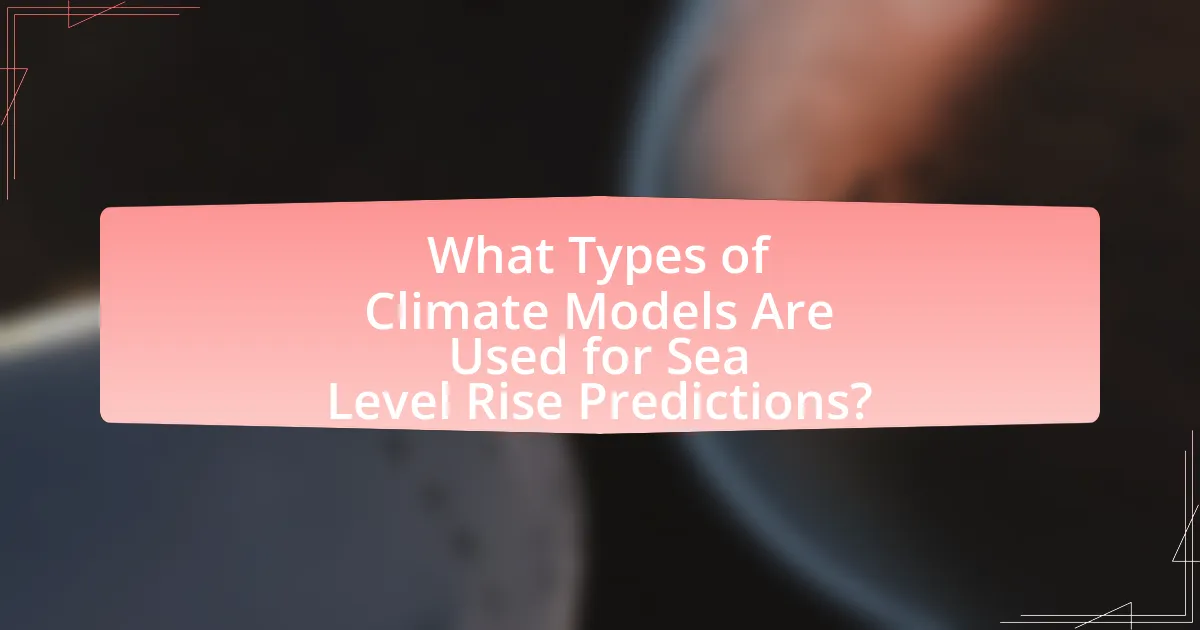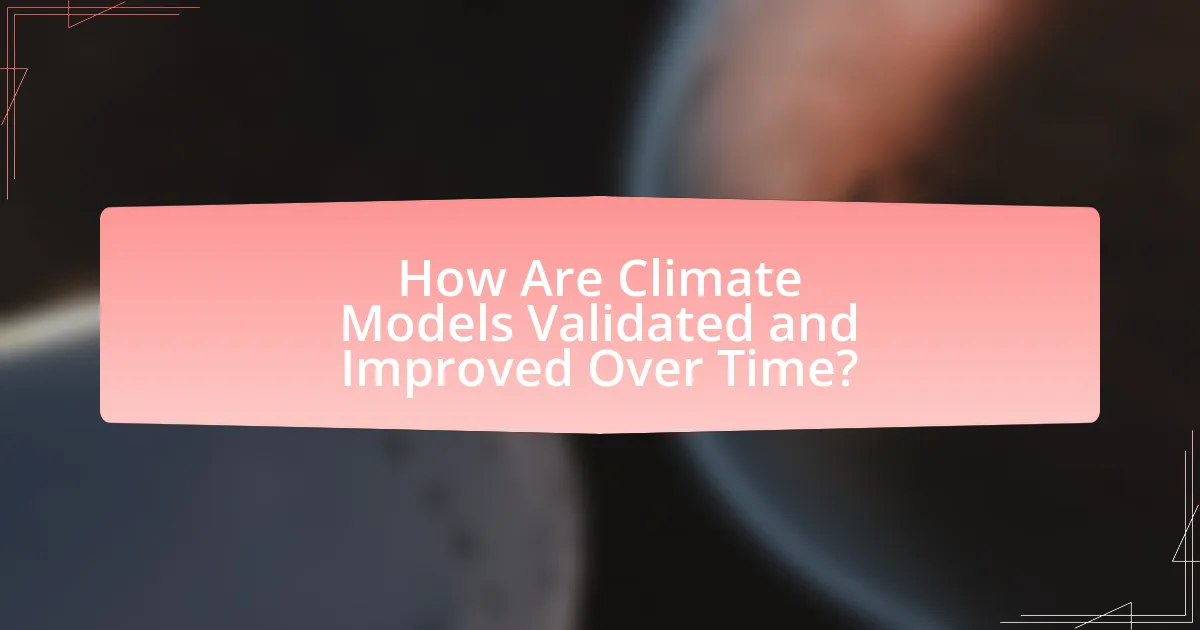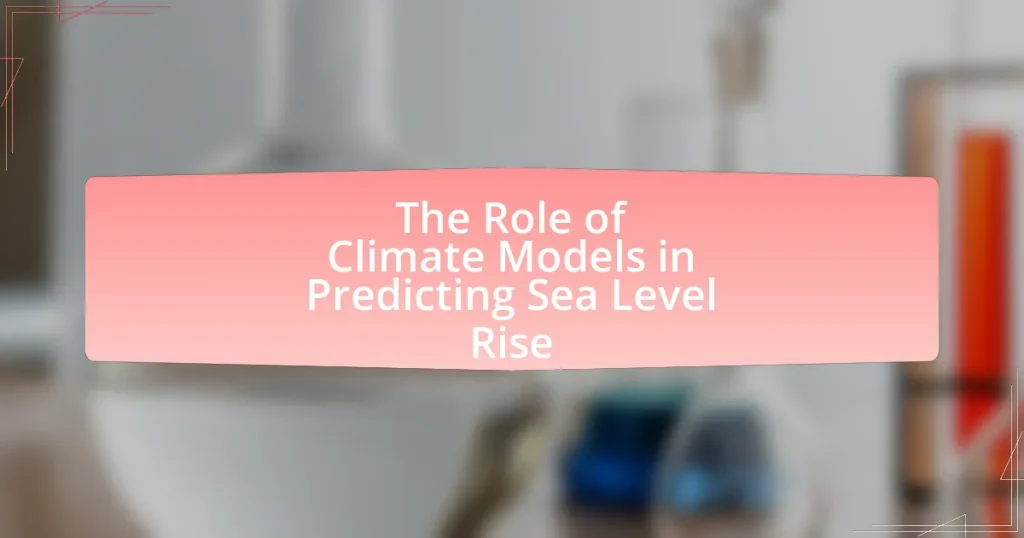Climate models are advanced computational tools essential for predicting future climate conditions, particularly sea level rise. These models simulate the Earth’s climate system by incorporating variables such as greenhouse gas emissions, ocean temperatures, and ice sheet dynamics. The article explores how climate models function, the key variables they consider, and their significance in forecasting sea level rise, which poses substantial risks to coastal communities and ecosystems. It also discusses the types of climate models used, their strengths and limitations, and the importance of accurate predictions for effective policymaking and community preparedness against climate change impacts.

What are Climate Models and Their Purpose in Predicting Sea Level Rise?
Climate models are sophisticated computational tools that simulate the Earth’s climate system to predict future climate conditions, including sea level rise. These models incorporate various factors such as greenhouse gas emissions, ocean temperatures, and ice sheet dynamics to project how climate change will affect sea levels over time. For instance, the Intergovernmental Panel on Climate Change (IPCC) reports that sea levels could rise by 0.3 to 1.1 meters by 2100, depending on emission scenarios, demonstrating the critical role of climate models in understanding potential future impacts.
How do climate models simulate the Earth’s climate system?
Climate models simulate the Earth’s climate system by using mathematical equations to represent physical processes such as radiation, convection, and ocean currents. These models incorporate data on atmospheric composition, land surface characteristics, and ocean temperatures to predict climate behavior over time. For instance, General Circulation Models (GCMs) divide the Earth into a three-dimensional grid and calculate the interactions between different components of the climate system, allowing for the simulation of weather patterns and long-term climate trends. The accuracy of these models is validated through historical climate data, demonstrating their effectiveness in predicting phenomena like sea level rise, which is influenced by thermal expansion of water and melting ice sheets.
What key variables do climate models take into account?
Climate models take into account key variables such as greenhouse gas concentrations, temperature, precipitation patterns, ocean currents, and ice sheet dynamics. These variables are essential for accurately simulating climate systems and predicting future climate scenarios. For instance, greenhouse gas concentrations directly influence global warming, while ocean currents affect heat distribution across the planet. Additionally, the dynamics of ice sheets are critical for understanding potential sea level rise, as melting ice contributes significantly to rising ocean levels.
How do these variables influence predictions of sea level rise?
Variables such as greenhouse gas emissions, ocean temperature, and ice sheet dynamics significantly influence predictions of sea level rise. Greenhouse gas emissions lead to global warming, which causes thermal expansion of seawater and melting of glaciers and ice sheets, contributing to rising sea levels. For instance, the Intergovernmental Panel on Climate Change (IPCC) reports that a 1°C increase in global temperature could result in an additional 0.3 to 1.2 meters of sea level rise by 2100, depending on emissions scenarios. Ocean temperature affects the density and volume of seawater, while ice sheet dynamics, particularly in Greenland and Antarctica, determine the rate at which ice is lost to the ocean. Studies have shown that the West Antarctic Ice Sheet is particularly vulnerable, with potential contributions of several meters to sea level rise if it collapses. Thus, these variables are critical in refining climate models and improving the accuracy of sea level rise predictions.
Why is predicting sea level rise important?
Predicting sea level rise is important because it enables communities to prepare for and mitigate the impacts of climate change. Accurate predictions help inform infrastructure planning, disaster response, and environmental conservation efforts. For instance, the Intergovernmental Panel on Climate Change (IPCC) projects that global sea levels could rise by 0.3 to 1.1 meters by 2100, depending on greenhouse gas emissions scenarios. This data is crucial for coastal cities, as it allows them to assess risks such as flooding and erosion, ultimately guiding policy decisions and resource allocation to protect vulnerable populations and ecosystems.
What are the potential impacts of sea level rise on coastal communities?
Sea level rise significantly threatens coastal communities by increasing flooding, eroding shorelines, and contaminating freshwater resources. For instance, a study by the National Oceanic and Atmospheric Administration (NOAA) indicates that sea levels along the U.S. coastline could rise by up to 12 inches by 2050, leading to more frequent and severe flooding events. Additionally, rising waters can erode beaches and coastal infrastructure, with the U.S. Geological Survey estimating that coastal erosion could affect over 1,000 miles of U.S. coastline by 2100. Furthermore, saltwater intrusion into aquifers compromises drinking water supplies, impacting the health and sustainability of these communities.
How does sea level rise affect ecosystems and biodiversity?
Sea level rise negatively impacts ecosystems and biodiversity by inundating coastal habitats, leading to habitat loss and altered species distributions. For instance, salt marshes and mangroves, which serve as critical nurseries for many marine species, are particularly vulnerable; as sea levels rise, these ecosystems can be submerged, reducing their ability to support diverse wildlife. Additionally, species that rely on specific coastal environments may face extinction if they cannot migrate or adapt quickly enough to changing conditions. Research indicates that a one-meter rise in sea level could displace millions of people and significantly disrupt coastal ecosystems, highlighting the urgency of addressing this issue.

What Types of Climate Models Are Used for Sea Level Rise Predictions?
The types of climate models used for sea level rise predictions include General Circulation Models (GCMs), Regional Climate Models (RCMs), and Earth System Models (ESMs). GCMs simulate the Earth’s climate system by solving complex mathematical equations that represent physical processes, allowing for global climate projections. RCMs focus on specific regions, providing higher resolution data that can capture local climate variations and impacts on sea level. ESMs integrate biogeochemical cycles with climate processes, offering insights into how changes in carbon cycles affect sea level rise. These models are validated through historical climate data and are essential for understanding future sea level scenarios.
What are the differences between global and regional climate models?
Global climate models (GCMs) simulate climate patterns on a planetary scale, while regional climate models (RCMs) focus on smaller, specific areas. GCMs use coarse spatial resolution, typically around 100-300 kilometers, to represent large-scale atmospheric and oceanic processes, making them suitable for understanding global climate trends. In contrast, RCMs employ finer resolution, often less than 50 kilometers, allowing for detailed simulations of local climate phenomena, such as precipitation patterns and temperature variations.
The effectiveness of GCMs in capturing broad climate dynamics is evidenced by their use in the Intergovernmental Panel on Climate Change (IPCC) assessments, which rely on these models to project future climate scenarios. RCMs, however, are essential for localized impact studies, as they can incorporate specific topographical features and land-use changes, providing critical insights for regional climate adaptation strategies. This distinction highlights the complementary roles of both model types in climate research and their importance in predicting sea level rise impacts at various scales.
How do global climate models contribute to understanding sea level rise?
Global climate models contribute to understanding sea level rise by simulating the interactions between the atmosphere, oceans, and ice sheets under various greenhouse gas emission scenarios. These models project future climate conditions, allowing scientists to estimate thermal expansion of seawater and ice melt from glaciers and polar ice sheets, which are primary contributors to sea level rise. For instance, the Intergovernmental Panel on Climate Change (IPCC) reports indicate that, under high-emission scenarios, global sea levels could rise by over 1 meter by 2100, primarily due to these modeled processes.
What role do regional climate models play in localized predictions?
Regional climate models (RCMs) are essential for making localized predictions by providing high-resolution climate data that captures the specific geographical and climatic features of a region. RCMs downscale global climate model outputs, allowing for more accurate simulations of local weather patterns, temperature variations, and precipitation changes. For instance, studies have shown that RCMs can improve the accuracy of climate projections by up to 50% in certain areas compared to broader models, making them crucial for assessing impacts like sea level rise in coastal regions.
What are the strengths and limitations of different climate models?
Different climate models exhibit strengths and limitations that impact their effectiveness in predicting sea level rise. Strengths include their ability to simulate complex interactions within the climate system, such as ocean-atmosphere dynamics and greenhouse gas feedbacks, which enhance understanding of potential future scenarios. For instance, coupled ocean-atmosphere models can provide detailed projections of temperature and precipitation changes, which are critical for estimating sea level rise due to thermal expansion and ice melt.
However, limitations exist, including uncertainties in model parameters and assumptions, which can lead to varying projections. For example, differences in how models represent ice sheet dynamics can result in significant discrepancies in sea level rise estimates. Additionally, regional variations may not be accurately captured, as many models operate on a global scale, potentially overlooking localized effects. These strengths and limitations highlight the need for continuous refinement and validation of climate models to improve their predictive capabilities regarding sea level rise.
How do uncertainties in climate models affect sea level rise predictions?
Uncertainties in climate models significantly affect sea level rise predictions by introducing variability in projected outcomes. These uncertainties stem from factors such as incomplete understanding of climate processes, variability in greenhouse gas emissions scenarios, and limitations in model resolution. For instance, the Intergovernmental Panel on Climate Change (IPCC) reports that different models can yield sea level rise estimates ranging from 0.3 to 1.2 meters by 2100, depending on emission trajectories and model assumptions. This variability complicates planning and adaptation efforts, as stakeholders rely on precise predictions to inform infrastructure and policy decisions.
What advancements are being made to improve climate model accuracy?
Advancements in improving climate model accuracy include the integration of high-resolution satellite data and enhanced computational techniques. These advancements allow for more precise simulations of climate systems by capturing finer-scale processes and interactions. For instance, the use of machine learning algorithms has been shown to optimize model parameters and improve predictive capabilities, as demonstrated in research published by the National Oceanic and Atmospheric Administration, which highlighted a 20% increase in forecast accuracy when machine learning was applied to traditional models. Additionally, the incorporation of improved ocean and atmospheric data assimilation methods has led to better representation of climate variability, further enhancing model reliability.

How Are Climate Models Validated and Improved Over Time?
Climate models are validated and improved over time through a combination of observational data comparison, model intercomparison projects, and continuous refinement of model parameters. Validation occurs when model predictions are compared against real-world observations, such as temperature and precipitation data, to assess accuracy. For instance, the Coupled Model Intercomparison Project (CMIP) provides a framework for comparing different climate models, allowing researchers to identify strengths and weaknesses in their predictions. Improvements are made by incorporating new scientific findings, enhancing computational techniques, and adjusting model structures based on feedback from validation efforts. This iterative process ensures that climate models remain reliable tools for predicting phenomena like sea level rise, as evidenced by their increasing accuracy in simulating past climate conditions and projecting future scenarios.
What methods are used to validate climate model predictions?
Climate model predictions are validated using several methods, including comparison with historical climate data, cross-validation with other models, and the use of observational data from satellites and ground stations. Historical climate data allows researchers to assess how well models replicate past climate conditions, while cross-validation involves running multiple models to check for consistency in predictions. Observational data provides real-time measurements that can be compared against model outputs to evaluate accuracy. These methods collectively ensure that climate models are reliable tools for predicting future climate scenarios, including sea level rise.
How do historical data and observations inform model validation?
Historical data and observations are critical for model validation as they provide a benchmark against which model predictions can be compared. By analyzing past climate patterns, researchers can assess the accuracy of climate models in simulating sea level rise. For instance, historical sea level records from tide gauges and satellite altimetry allow scientists to evaluate how well models replicate observed trends over time. Studies, such as those published in the journal “Nature,” demonstrate that models calibrated with historical data yield more reliable forecasts, as they incorporate real-world variability and extremes. This empirical foundation enhances the credibility of climate models, ensuring they are robust in predicting future sea level changes.
What role does peer review play in the validation process?
Peer review serves as a critical mechanism in the validation process by ensuring that research findings are rigorously evaluated by experts in the field before publication. This evaluation helps to identify any methodological flaws, biases, or inaccuracies in the research, thereby enhancing the credibility and reliability of the findings. For instance, studies published in reputable journals often undergo multiple rounds of peer review, which can include statistical analysis and replication of results, ensuring that the conclusions drawn about climate models and their predictions of sea level rise are based on sound scientific principles. This process not only strengthens the validity of individual studies but also contributes to the overall integrity of scientific literature, fostering trust in the predictive capabilities of climate models.
How can climate models be improved for better predictions?
Climate models can be improved for better predictions by enhancing their resolution and incorporating more accurate representations of physical processes. Higher resolution allows models to capture local climate variations and extreme weather events more effectively. For instance, the Coupled Model Intercomparison Project (CMIP) has shown that models with finer spatial resolution yield more reliable projections of regional climate impacts. Additionally, integrating advanced data assimilation techniques and machine learning can refine model outputs by utilizing real-time observational data, thereby increasing predictive accuracy. Research indicates that models incorporating these improvements can reduce uncertainty in projections, as evidenced by the Intergovernmental Panel on Climate Change (IPCC) reports, which highlight the importance of continuous model refinement for reliable sea level rise predictions.
What technological advancements are enhancing climate modeling?
Technological advancements enhancing climate modeling include high-resolution satellite observations, advanced supercomputing capabilities, and machine learning algorithms. High-resolution satellite observations, such as those from NASA’s Sentinel-6, provide precise data on sea level changes, improving model accuracy. Advanced supercomputing allows for more complex simulations, enabling researchers to run detailed climate models that incorporate numerous variables and scenarios. Machine learning algorithms analyze vast datasets to identify patterns and improve predictive capabilities, as demonstrated in studies like “Deep Learning for Climate Science” by Rasp et al., which shows significant improvements in forecasting accuracy. These advancements collectively contribute to more reliable climate models, crucial for predicting sea level rise.
How does interdisciplinary research contribute to model improvements?
Interdisciplinary research enhances model improvements by integrating diverse methodologies and perspectives from various fields, leading to more comprehensive and accurate climate models. For instance, collaboration between climatologists, oceanographers, and social scientists allows for the incorporation of complex interactions between climate systems and human activities, which is crucial for predicting sea level rise. Studies have shown that models incorporating socio-economic factors alongside environmental data yield better predictions, as evidenced by the work of the Intergovernmental Panel on Climate Change (IPCC), which emphasizes the importance of multi-disciplinary approaches in climate modeling. This integration not only improves the accuracy of predictions but also enhances the models’ ability to inform policy decisions and adaptation strategies.
What Practical Steps Can Be Taken to Address Sea Level Rise Predictions?
To address sea level rise predictions, practical steps include implementing coastal defenses, enhancing natural barriers, and adopting sustainable land-use planning. Coastal defenses, such as sea walls and levees, can protect vulnerable areas from flooding. Enhancing natural barriers, like restoring wetlands and mangroves, provides additional protection while also supporting biodiversity. Sustainable land-use planning involves restricting development in high-risk areas and promoting the relocation of critical infrastructure away from coastlines. According to the Intergovernmental Panel on Climate Change (IPCC), proactive measures can significantly reduce the risks associated with sea level rise, emphasizing the importance of early action in mitigating potential impacts.
How can policymakers use climate model predictions to inform decisions?
Policymakers can use climate model predictions to inform decisions by integrating these forecasts into planning and regulatory frameworks. Climate models provide projections of future sea level rise, which can guide infrastructure development, zoning laws, and disaster preparedness strategies. For instance, the Intergovernmental Panel on Climate Change (IPCC) reports indicate that sea levels could rise by up to 1.1 meters by 2100 under high greenhouse gas emissions scenarios. This data enables policymakers to assess risks and prioritize investments in coastal defenses and sustainable land use practices, ensuring communities are better prepared for future climate impacts.
What actions can communities take to prepare for potential sea level rise impacts?
Communities can prepare for potential sea level rise impacts by implementing adaptive infrastructure measures, such as constructing sea walls, restoring wetlands, and elevating buildings. These actions help mitigate flooding risks and protect coastal ecosystems. For instance, a study by the National Oceanic and Atmospheric Administration (NOAA) indicates that investing in natural barriers like wetlands can reduce storm surge impacts by up to 50%. Additionally, communities can develop land-use planning strategies that restrict development in high-risk areas, ensuring that future growth is resilient to rising sea levels.

